For many people, trailering a boat is a good—and perhaps the only—way to get out on the water. Unfortunately, the trailer is often the very last thing the builder thinks about. After spending all that money and time building the boat, it is tempting to economize by buying a cheap, too-light rig. That’s a bad idea. A too-small trailer is not only short-lived, it’s also dangerous.
Like building the boat, the business of trailering begins with planning. The first step in formulating the plan is to check the tow rating of your vehicle to get an idea of how large a trailer you can haul. It’s best, however, to take those ratings with a grain of salt, for almost any vehicle will haul a glued-lap Whitehall a few miles over moderate terrain to the local launch ramp; such a scenario is unlikely to test the mettle of your automatic transmission’s cooling system or your radiator, or to push your tires to their limit. It’s quite another thing, however, to attempt towing your brand-new mahogany-planked Haven 12-1/2 (see page 90) with a 1978 Subaru through the Rockies in summer. In this case, a bit more consideration needs to be given to tow-vehicle selection and upkeep.
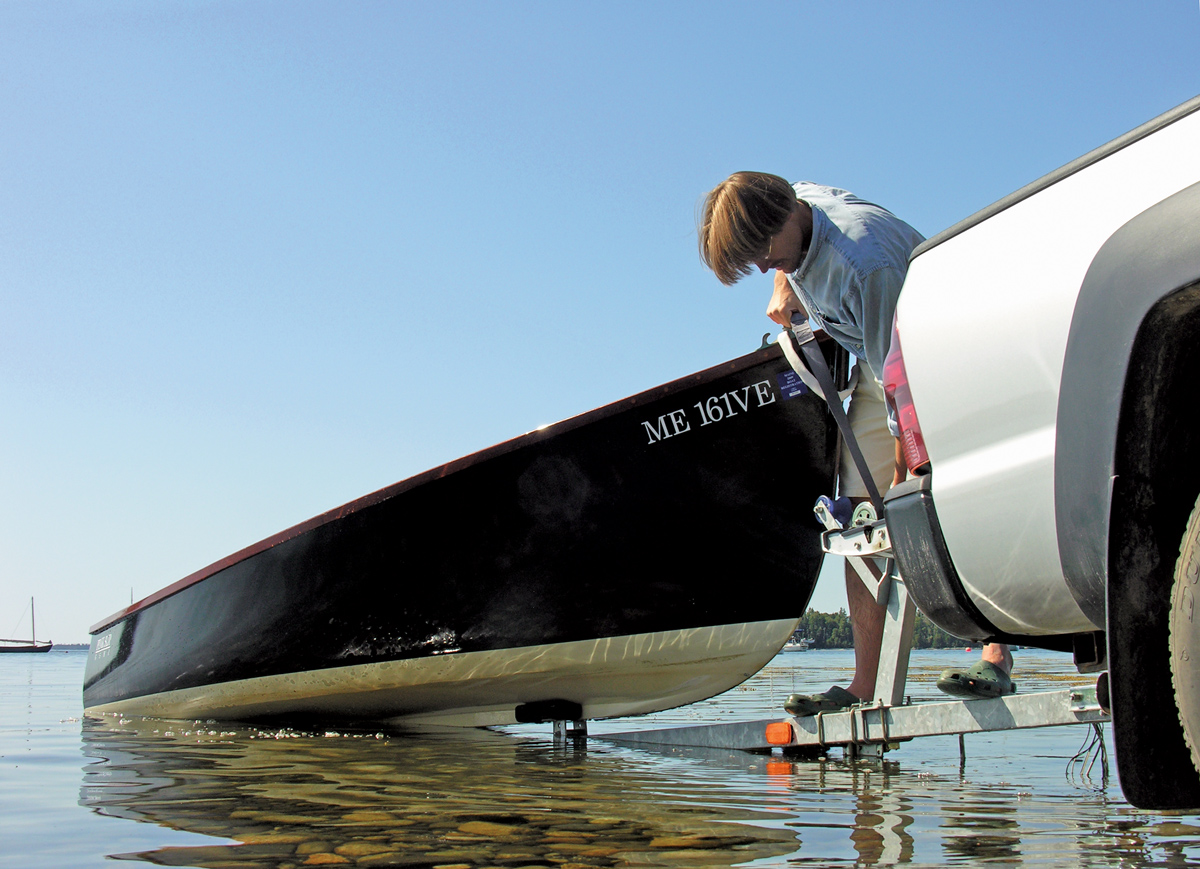 Photo by Matthew P. Murphy
Photo by Matthew P. MurphyA proper towing vehicle, a trailer well-matched to the boat and properly maintained, and a good grasp of procedures, are the elements of safe trailering. Here, Aaron Porter prepares to haul his Jericho Bay Lobster Skiff.
For example, an old friend, Bruce Armstrong, regularly takes his 20′ Tolman Skiff with outboard mounted from Southern California to Lake Powell in September. He reports running 70 mph in 100-degree heat, climbing 5,000′ grades in company with dozens of 18-wheelers. Bruce, noting “failure is not an option,” drives an industrial-strength 2001, 245-hp High Output Cummins powered Dodge 4×4 rated to tow 13,500 lbs.
While Bruce’s rig might be overkill for your situation, there are still many factors to consider when setting up for trailering. The following are some things to consider as you formulate your plan.
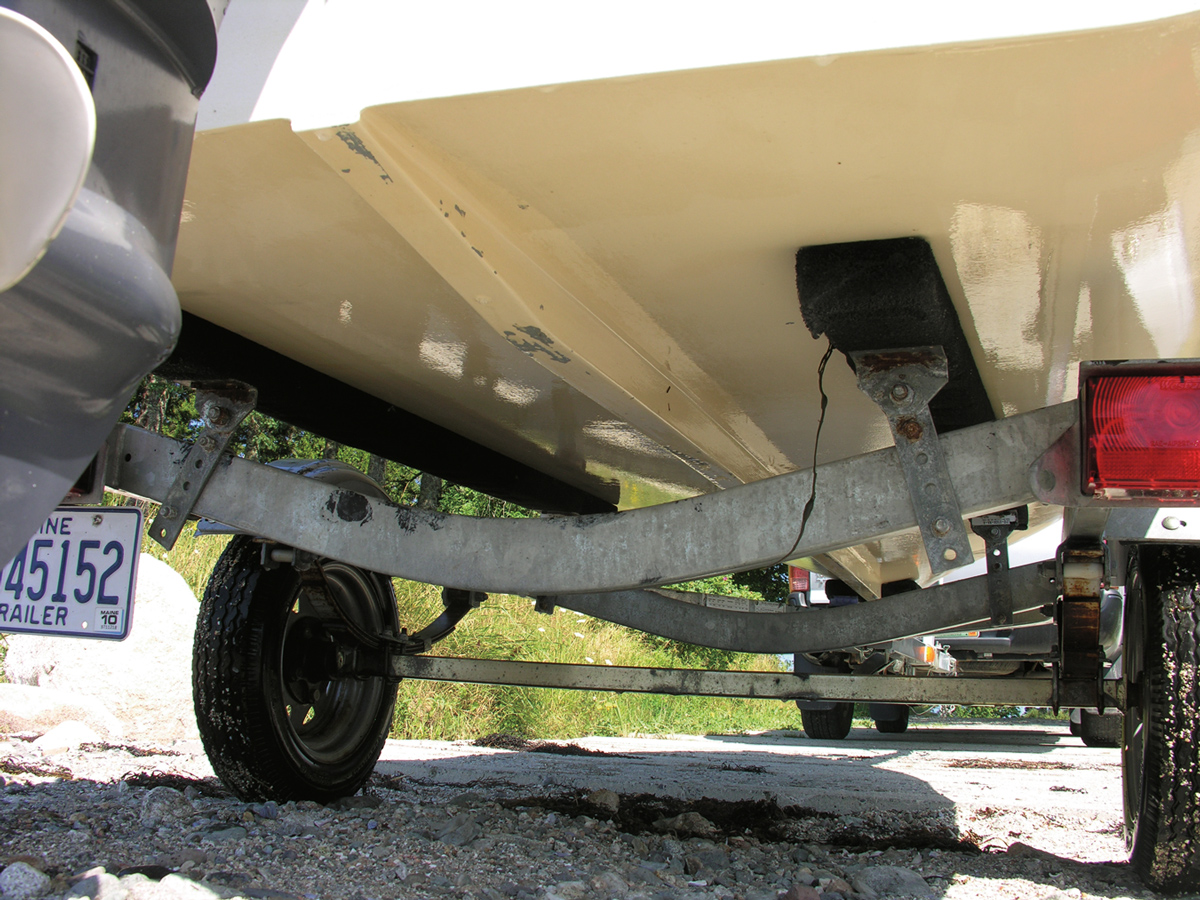 Photo by Matthew P. Murphy
Photo by Matthew P. MurphyCarpeted bunks distribute the weight of a hull evenly, and allow the boat’s position on the trailer to be adjusted without damage to the bottom.
What Size Trailer?
Once you’ve determined your vehicle’s towing capacity, the next thing is to determine how much your boat weighs. For a small boat, if you don’t trust the weight specified in the design, this can often be done with simple bathroom scales. Another way to go is to place the boat on a borrowed trailer and take it to a truck scale. Bring the boat back home and weigh the trailer alone. Subtract this weight from the total boat-plus-trailer weight to give you the actual weight of the boat.
U.S. federal law requires that a trailer display its “Gross Vehicle Weight Rating” (GVWR), which is the total weight of boat and gear. When figuring the weight of the loaded trailer, be sure to include the boat, engine, gasoline (6 lbs per U.S. gallon), water (8 lbs per U.S. gallon), and gear. A useful margin of safety is that the total weight be no more than 85 percent of the GVWR. For larger boats, a tandem-axle trailer might be considered. They track better and are less prone to fishtail than single-axle trailers. Also, the extra wheels offer safer handling in case of a blowout.
Just as the trailer must be properly sized to the boat’s length and weight, the boat also needs to be properly braced, or cradled, by rollers and bunks—as least as well as when storing the vessel for winter. Boats are used to being uniformly supported by the water. When it’s out of the water, the boat has all the strain taken up at just a few places. Traditional wooden boats need more support than fiberglass ones. If necessary, augment the manufacturer’s standard equipment with homemade structures. Firehose-covered removable bunks will go a long way toward protecting the hull against the stress and strain of over-the-road travel; generally, they’re better than rollers, which tend to point-load a planked wooden hull, and thus cause damage. Outboard-powered wooden boats present a special problem, as the weight of the overhanging engine can stress the hull and even hog the keel. The transom should be directly and fully supported by a full trailer cross member.
Tongue Weight
Tongue weight is the weight of the trailer’s tongue at the vehicle. The general rule is that it be 10 percent of the total combined weight of boat and trailer. Too much weight on the tongue puts excessive stress on the towing vehicle’s suspension. Excessive tongue weight can also cause steering problems by reducing the weight on the vehicle’s front wheels. Conversely, if there is too much weight on the after portion of the trailer, it can sway and get twitchy, weaving back and forth. Weight can be adjusted by moving the boat back and forth, checking it with a scale.
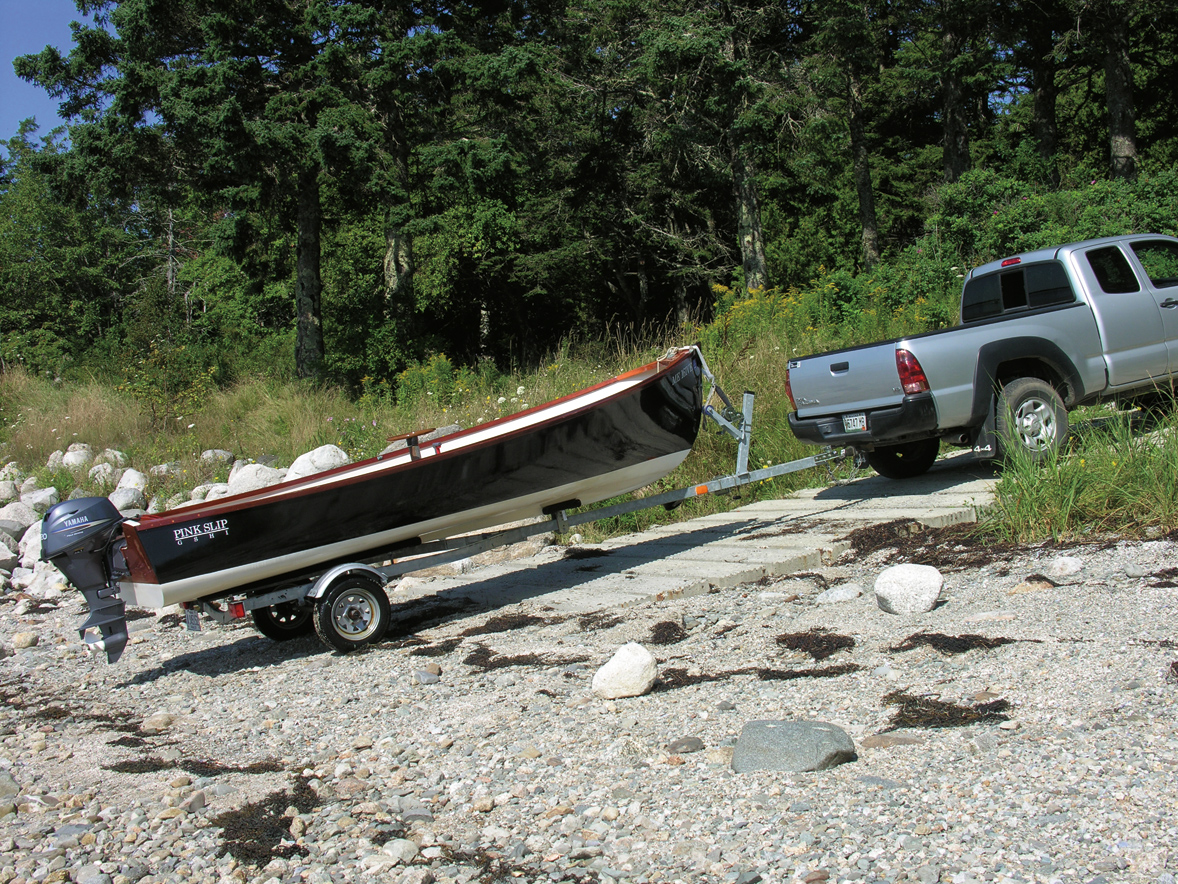 Photo by Matthew P. Murphy
Photo by Matthew P. MurphyBefore going down the road, the boat’s position on the trailer should be evaluated; 10 percent of the total trailer-plus-boat weight should be on the tongue.
Trailer Hitches
There are four classes of hitches; these are rated according to the weight (GVWR) they will be pulling. The ratings are as follows:
Class I: ……………………………………. 2,000 lbs
Class II: ………………………………….. 3,500 lbs
Class III: …………………………………. 5,000 lbs
Class IV: …………………………………. 10,000 lbs
Galvanized or Paint?
Unless the trailer is used only in fresh water, galvanized trailers will last longer and require less maintenance. Regardless of whether the trailer is galvanized or not, a thorough rinsing with fresh water after each saltwater immersion will also extend the life of the trailer. When rinsing, pay particular attention to the axles, which tend to rust more quickly than the trailer frame.
A Fitted Cover
A dandy trailer accessory is a fitted travel cover. This will keep the boat’s interior clean of road dirt during transit, saving cleanup time before launching. And, like those interior luggage compartment covers in passenger vehicles, a travel cover will also help keep expensive boat bits safe from prying eyes at rest stops.
A cover—especially a canvas one—is also great for helping to keep a wooden boat tight while it’s parked in the yard. Canvas ventilates when it’s dry, allowing fresh air in; when wet, the canvas swells a bit, keeping rainwater out.
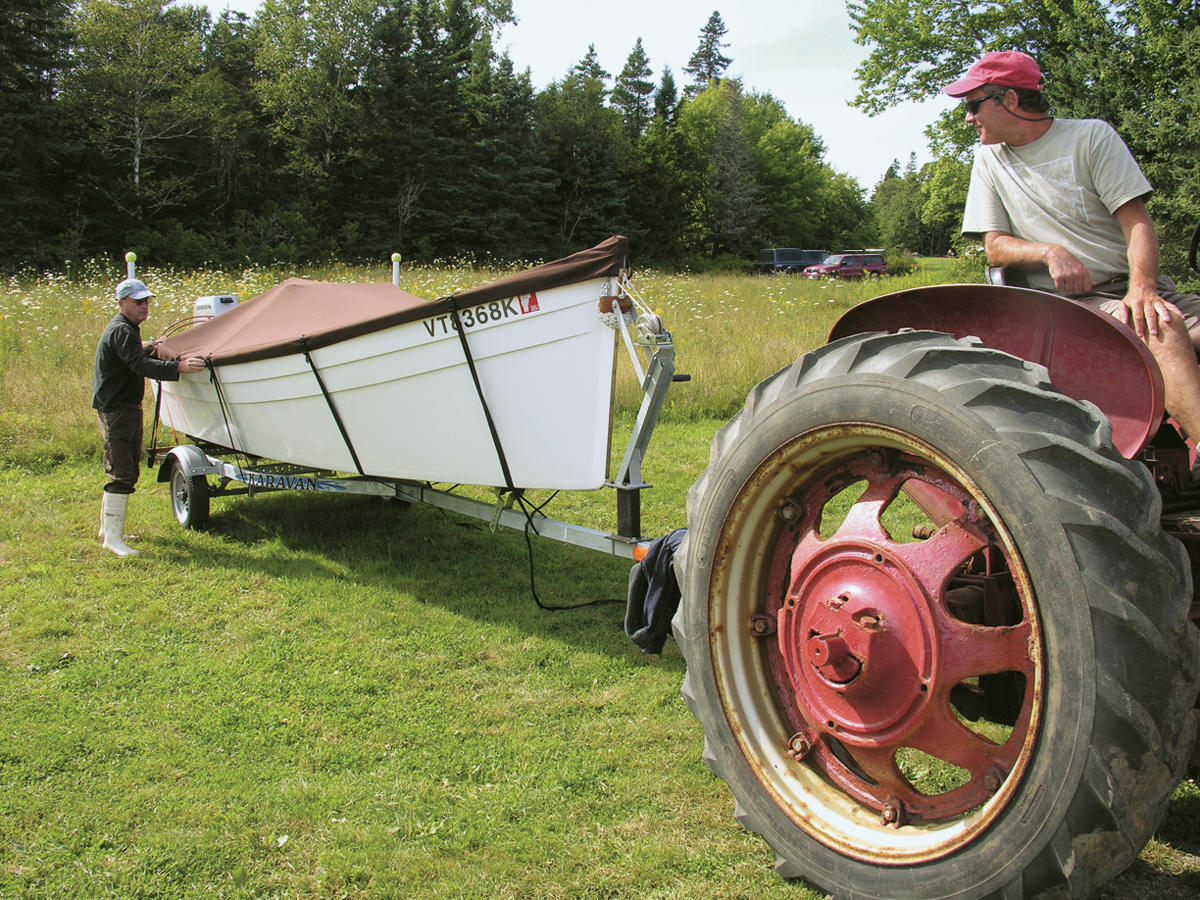 Photo by Matthew P. Murphy
Photo by Matthew P. MurphyA surprising amount of debris can be kicked up by highway travel. A well-fitted and -secured cover will guard against this.
Wheels and Tires
A tire or bearing failure going down the road at high- way speeds is bad news, yet in the rush to get going, often the running gear of a trailer is overlooked. To that end, let’s take a look underneath.
If you are buying a new trailer, consider one with larger wheels, as they do not have to work as hard as smaller ones. If you have purchased a used trailer, start by inspecting the tires. Do they have enough tread? Are they inflated properly to the manufacturer’s specifications? Inspect them for rot, cracking, and cuts. If in doubt, replace the tires. Trailer tires have thicker sidewalls than automobile tires. Be sure the previous owner did not mix bias-belted and radial tires; the trailer won’t track properly in this case. Take a look at the wheels: Salt water can raise the dickens with trailer rims. If they are rusty, give them a wire-brushing and look closer. If the wheel is too corroded and porous, it may not properly hold air. After cleaning, give the wheels a good coat of protective paint.
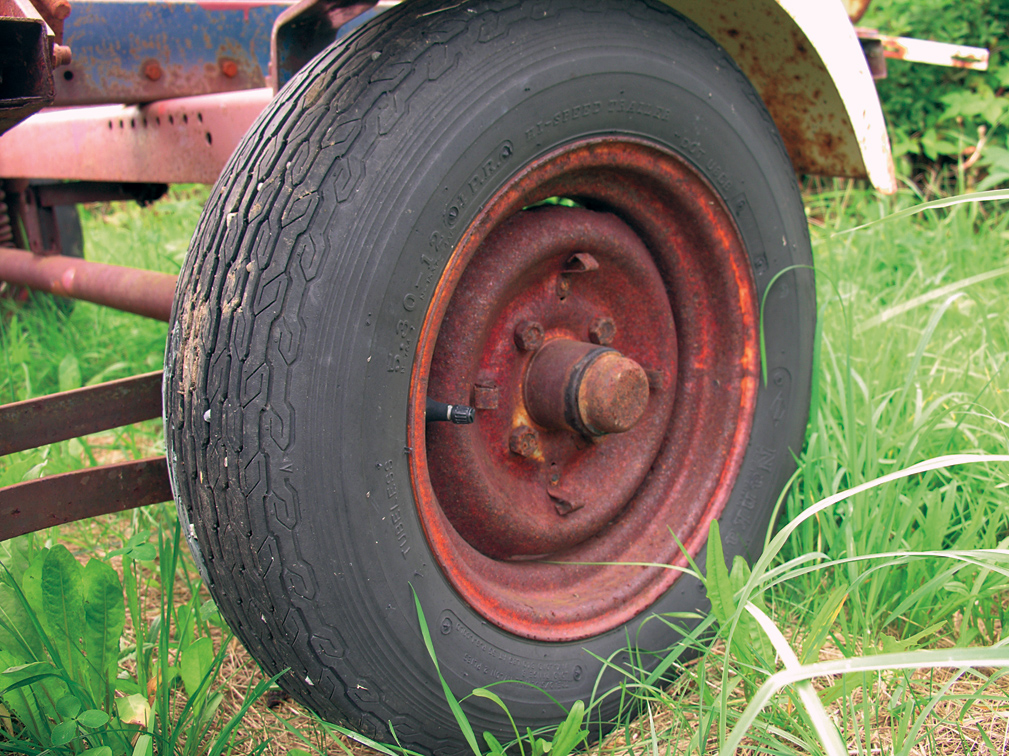 Photo by Matthew P. Murphy
Photo by Matthew P. MurphyWheels and tires should be inspected for rust and cracks. The example we see here is fine for a yard trailer, but questionable for over-the-road service.
Over time, when launching, water can infiltrate the protective cover over the wheel bearings and cause them to wear or fail. It’s a good idea to annually jack up the wheels (one at a time) to check the bearings on the hub. Place a hand on either side of the wheel and rock it in and out to check for movement. There should be a slight amount of play, but if it is excessive the bearing may need to be adjusted or replaced. Some trailer owners use an aftermarket wheel-bearing protector like the “Bearing Buddy,” which is designed to keep a slight pressure of grease between the inside of the hub and the outside environment; this deters water infiltration into the axle hub. Bearing upkeep requires a couple of shots of grease before every trailer submersion. Savvy long-distance towers like my friend Bruce carry spare sets of bearings, tubes of grease, and adequate tools on long trips; they might also carry an entire hub-and-bearing assembly with them, mounted on a spare wheel and tire, ready to install by simply removing the cotter key and axle nut. Before going on a long tow, give the bearings one last inspection.
In many U.S. states, trailers with a GVWR of 1,500 lbs or more are required to have brakes on all wheels. If your trailer has brakes on the wheels, they, too, should be inspected. If you haven’t done this task in a while, it would be worthwhile taking the rig down to the local garage for the job.
Going Down The Road
With the inspections complete, we’re ready to hit the road. Before heading out, be sure the boat is properly tied down. At the bow, the winch cable and a safety stop line should be in place. There should be transom and ’midship tie-downs as well. Trailer hitch safety chains should be inspected. These chains should be attached to the towing vehicle with strong S-hooks or shackles. The chains should be crossed. They should be long enough to permit tight turns yet short enough to suspend the trailer tongue and keep it from slamming into the pavement if the hitch fails. Everything in the trailer should be properly stowed to prevent it flying out en route. Inspect the lights to confirm that they are, indeed, working. Check the wheel lug nuts and bring along your trailer jack, wheel nut wrench, breaker bar, and chocks. And don’t forget the roadside warning devices—reflective triangles, flares, etc. You’ll be glad you did.
While on the road, make a habit of checking on the trailer via the rear-view mirrors. Drive at moderate speeds and avoid sudden stops. You have probably doubled your customary wheel-base length—a good thing to keep in mind when passing or pulling through an intersection. Make wider turns at curves and corners. Because your trailer’s wheels are closer to the inside of a turn than the wheels of your tow vehicle, they are more likely to hit or ride up over curbs. Slow down when traveling bumpy dirt roads or when crossing railroad tracks. And allow more space for braking.
Stop and inspect the boat and trailer at regular intervals. Check the tie-downs and tire pressure. Feel the wheel bearing cover; it’s okay for it to be warm, but not hot. Inspect the hitch; it may need to be retightened. Are those lights still working?
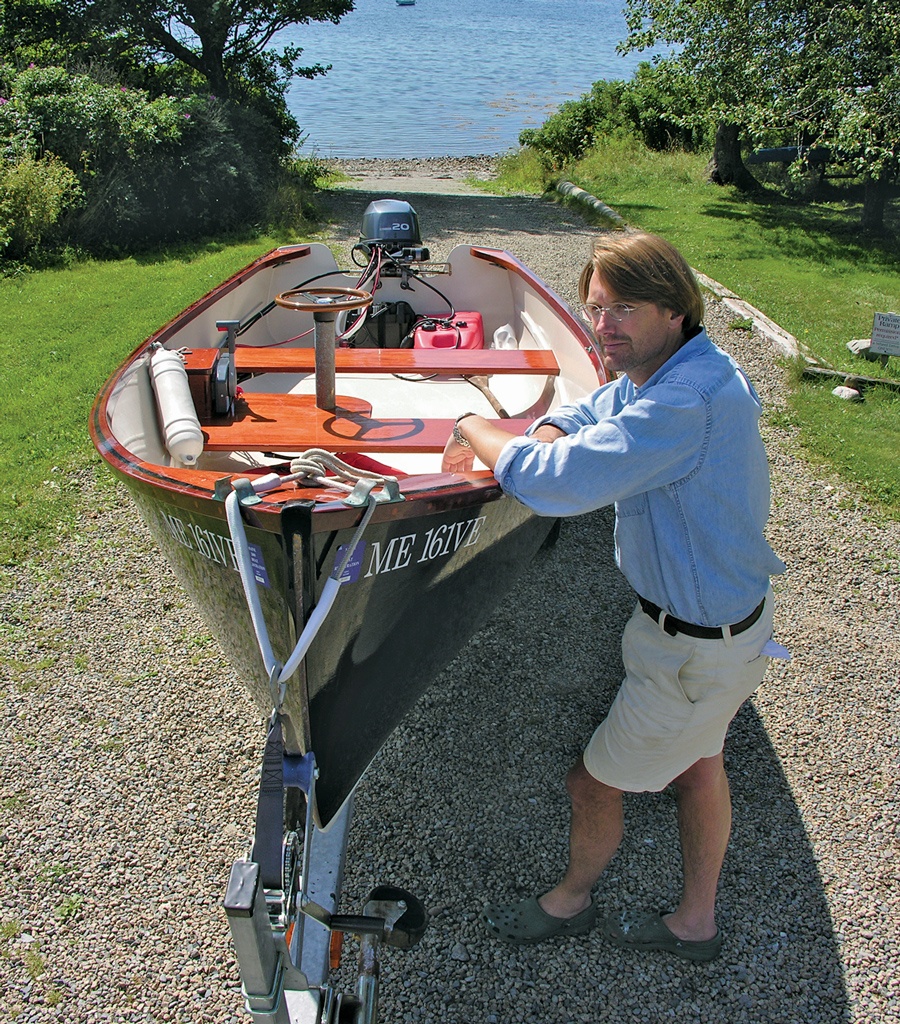 Photo by Matthew P. Murphy
Photo by Matthew P. MurphyThe Jericho Bay Lobster skiff is almost ready to travel. It’s well secured at the bow, but awaits a final stowing of gear. The hull will need to be secured to the trailer, too.
Launching the Boat
A warm summer day can cause the local launching ramp to be a busy place, complete with lots of different kinds of boats and the corresponding personalities of those who own them. One thing they all have in common is that they all want to get into the water at the same time. It pays to be as organized as possible to expeditiously back the trailer into the water, pull the empty trailer out of the way, get loaded up, and clear the ramp.
Launching a boat is akin to landing an airplane: You are transitioning from one medium to another. If there is going to be a problem, this is a likely place for it to happen. So, it’s always good to plan ahead.
If you are new to backing a trailer, practice in a parking lot or field before getting to the launching ramp. While not difficult, it does take a bit of getting used to—whether you use mirrors or are able to crane your head around to see what is going on. Our man Bruce recommends the following: “When ready to start backing your rig, place your steering-wheel hand on the bottom of the steering wheel, look at your trailer in the rear-view mirror, and turn your hand in the direction you want your trailer to go as you engage reverse.” Back slowly, and if the trailer starts to jackknife, simply pull ahead a bit to realign the trailer and start again.
Launching your vehicle along with the boat is always considered poor form. It has been done. To avoid such an inconvenient situation, check the parking brake. Does it actually work, or is it merely ornamental and used only at vehicle inspection time? Try it on a steep hill. Putting a vehicle in “park” on a ramp and leaving the engine running is a seriously bad idea. Newspapers carry stories on a regular basis of cars driving off without their astonished owners who had dutifully “put their car in park”—on a level surface. It’s better to turn the engine off, with the transmission in park (or on a manual transmission, in first gear if the vehicle is pointed downhill, and in reverse if pointed uphill). If in doubt, have wheel chocks at the ready for insertion behind the rear wheels.
Remove all tie-downs and have everything (especially life jackets) ready to go, on the boat, before heading down the ramp. Have as much gear on board as possible, rig the mast (if you have one), have docklines and fenders ready, and (if it has one) test the boat’s engine ahead of time—especially if this is the first trip of the season— even if it ran great last fall. Disconnect the trailer-light coupling. Oh, and don’t forget the drain plug.![]()
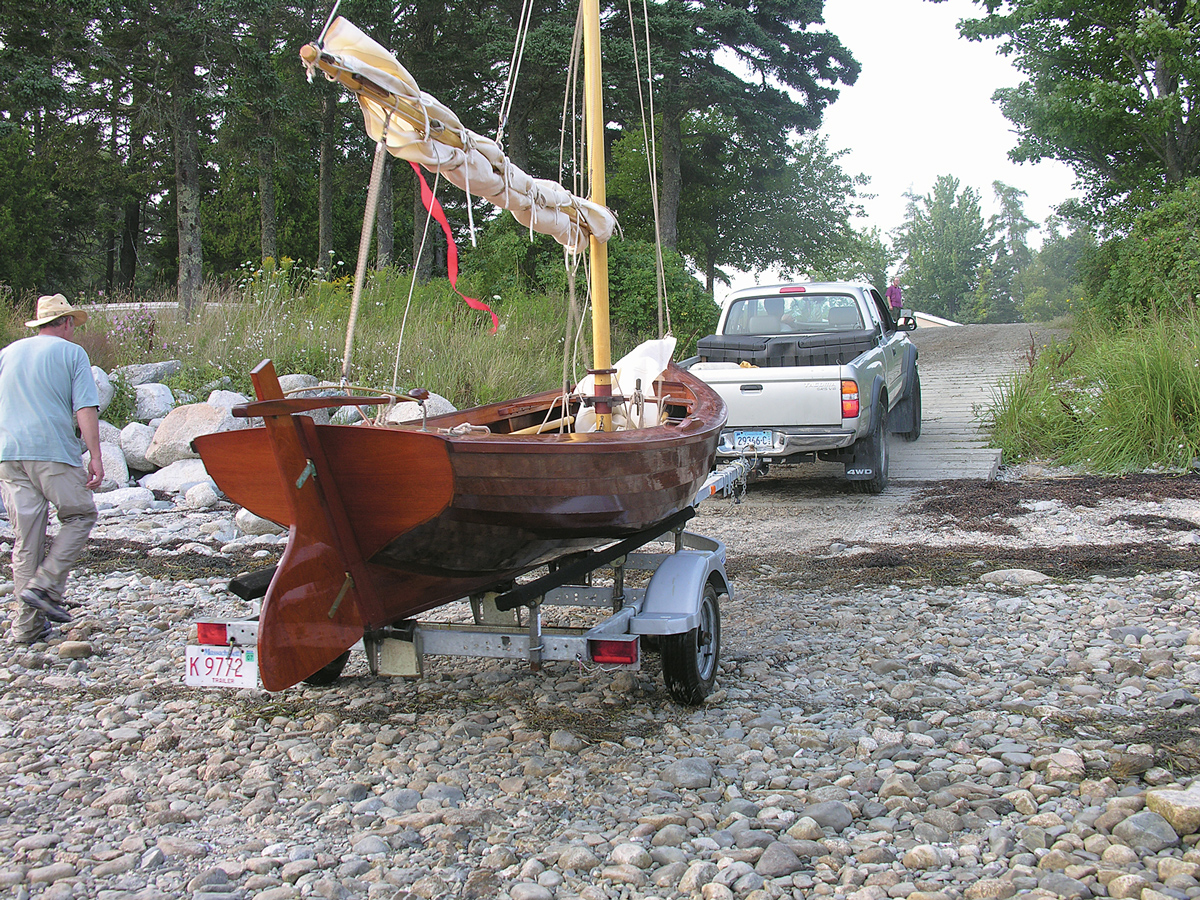 Photo by Matthew P. Murphy
Photo by Matthew P. MurphyWith mast stepped and sails rigged—and after a careful check for overhead power lines—the straps are removed and the boat is backed to the water. Proper backing of a trailer takes some practice; it’s wise to rehearse in private before taking to the stage of the launching ramp.
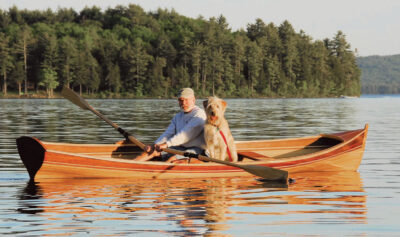

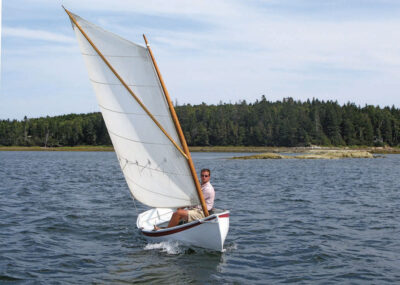
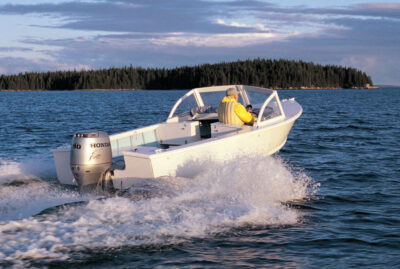
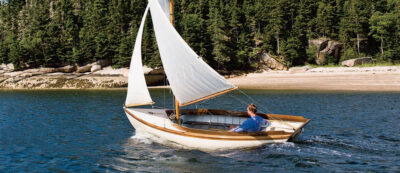
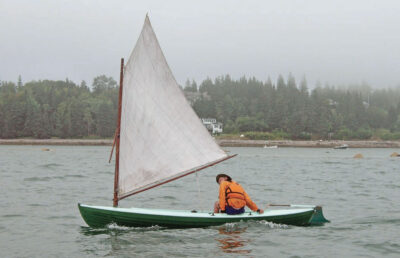


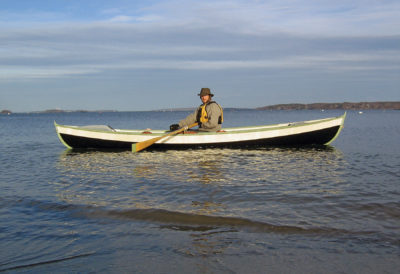
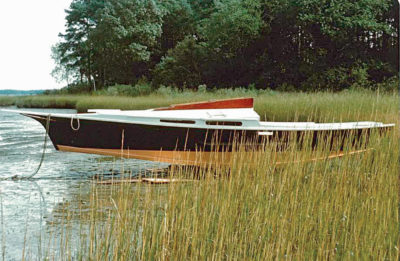
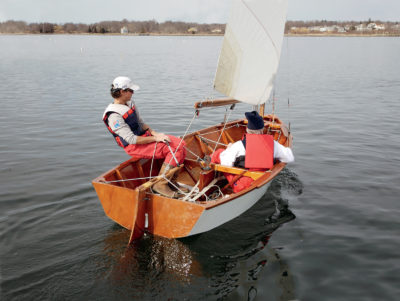
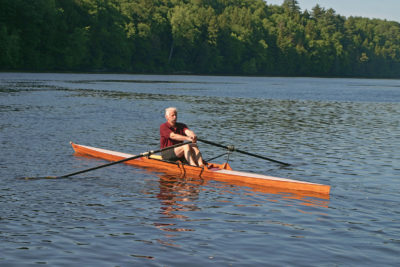
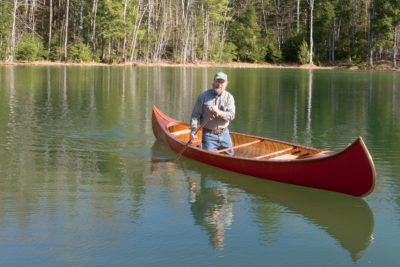
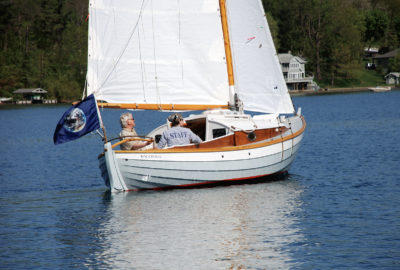
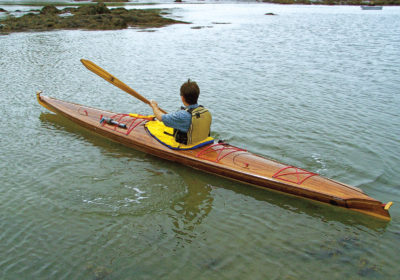
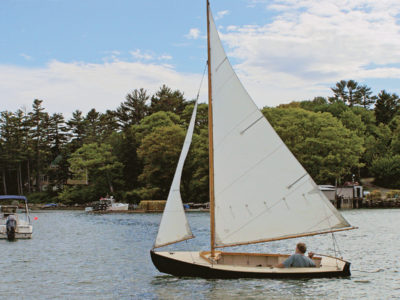
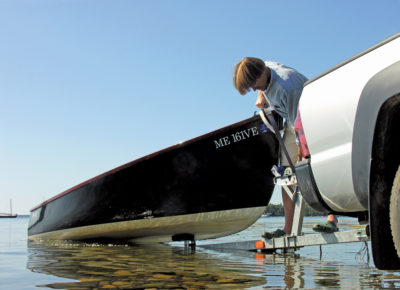
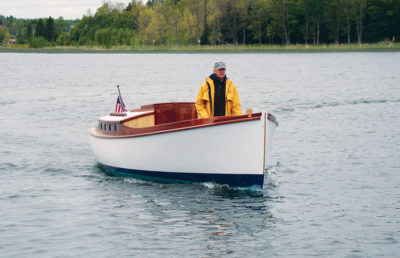
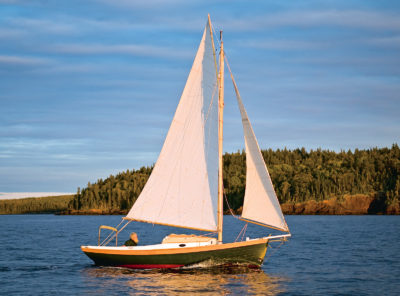
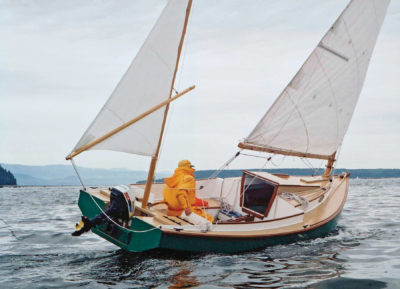
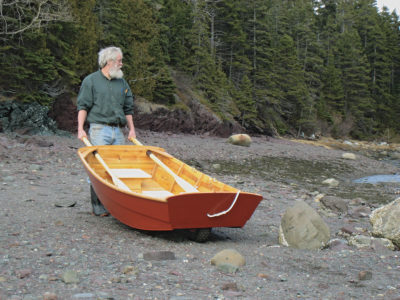
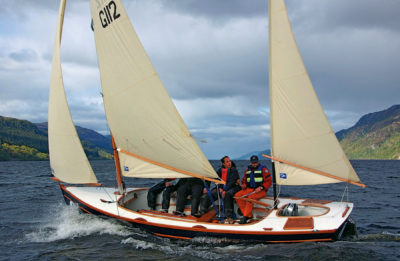
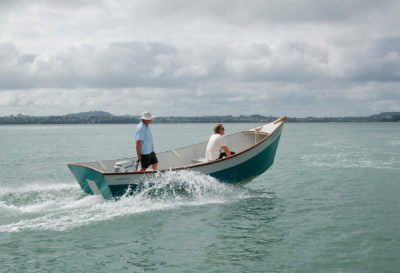

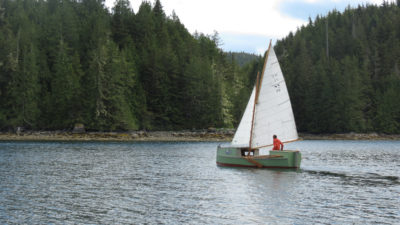


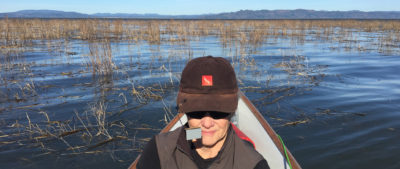
Great article. Ramp recon is a thing. We hopefully know before we head to a ramp that there are no power lines to mess with sailboat masts, look for the power and light poles, they are easier to spot than wires. Find the poles first and then scan for the wires, something we also did in the military when flying low-level helicopter routes. Even though we conducted a map study and identified hazards before a low level route, there were many times that uncharted wires were spotted.
Back to ramp recon: before we even rig we saunter down to the ramp and see if we can identify the sides and ends of the ramp. Not good to put a trailer wheel off the side, and there is usually a divot at the end of the ramp where big power boats have washed out the bottom while power loading. We look for the slime line on the ramp and try to avoid putting the tow vehicle wheels past that, although now our two main tow vehicles have all-wheel drive. We also check out the wind, current, and dock situation, that might lead us to pick one side of a ramp over the other, even if it means waiting a few minutes for another boater to launch from our preferred side. Skipper handles the dock lines, and she likes them set up on the same side that the dock will be on.
One other note on trailer tires: if buying a used trailer, check the load rating on the tires to make sure it is appropriate for the towed weight. Sometimes a previous owner may have bought the cheapest replacements, not knowing that there are different load ratings. And trailer tires should be no more than 6 years old, even if they look good, as microfissures would be beginning to form in the treads. There will be a MMYY (MonthYear) manufacture date on one side of the sidewall, if there is not, then the tire needs to be replaced.
Happy Boating,
Kent and Audrey
I worked in the marine industry for a lot of years and was a certified ShoreLandr trailer and ShoreStation tech. I have seen a number of trailer incidents from improper hookups/tie-downs, wrong-sized ball/receiver sizes, smoking bearings, broken axles, flat tires/no spare, as well as frame failures due to corrosion. These incidents that I mention are only going to and leaving boat ramps. Not only these mechanical I’ve seen plenty of nightmares launching and retrieving.
What really needs to be done is that the boater needs to develop a solid checklist and a consistent rhythm to this potentially hazardous activity of trailering. Besides, even the most experienced seasoned boat can look like an idiot sometimes.
It was mentioned in the article about boat/trailer covers. I prefer not using a cover in transit for two reasons: (1) trailing high speed can shred a cover and (2) on finely finished surfaces including gel/painted graphics covers, even the most expensive, can cause chafing and wearing. As with everything, the exception is pontoons. I prefer to put the cover on the boat when I get home.
One more thing I almost forgot. Always make sure the wheels/including the tongue jack are blocked when parked even when the surface looks flat. Trying to stop a boat, even a small boat, from rolling away can be very difficult, even dangerous. I’ve been in charge of a boatyard for a number of years; a runaway slow-rolling boat on a trailer on a driveway, storage building, or in a yard is a scary animal.
Take trailing as seriously as boating. Please don’t drink drive or pilot a boat no matter what the size of the vessel.
Another thing
Last item, make sure your boat has a line attached to something on the shore or dock before you float it off the trailer! I only did this once!
George
Also, if the boat has a drain plug, make sure it is properly installed. Something my father once forgot.